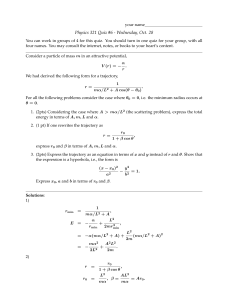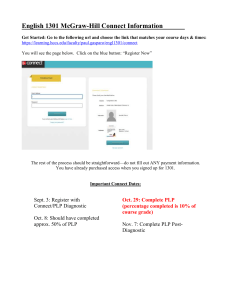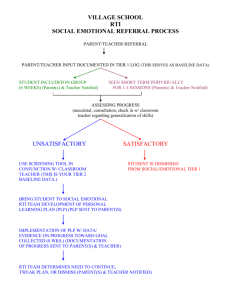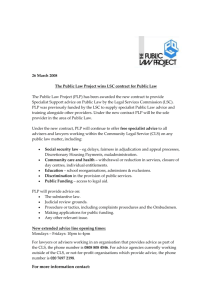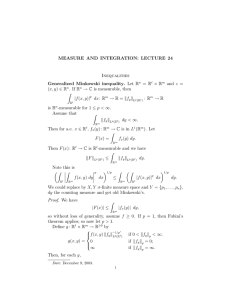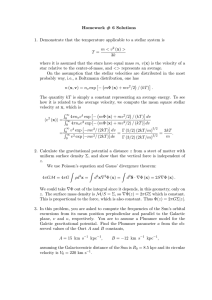Flexibility analysis on a supply chain contract using a Parametric
advertisement
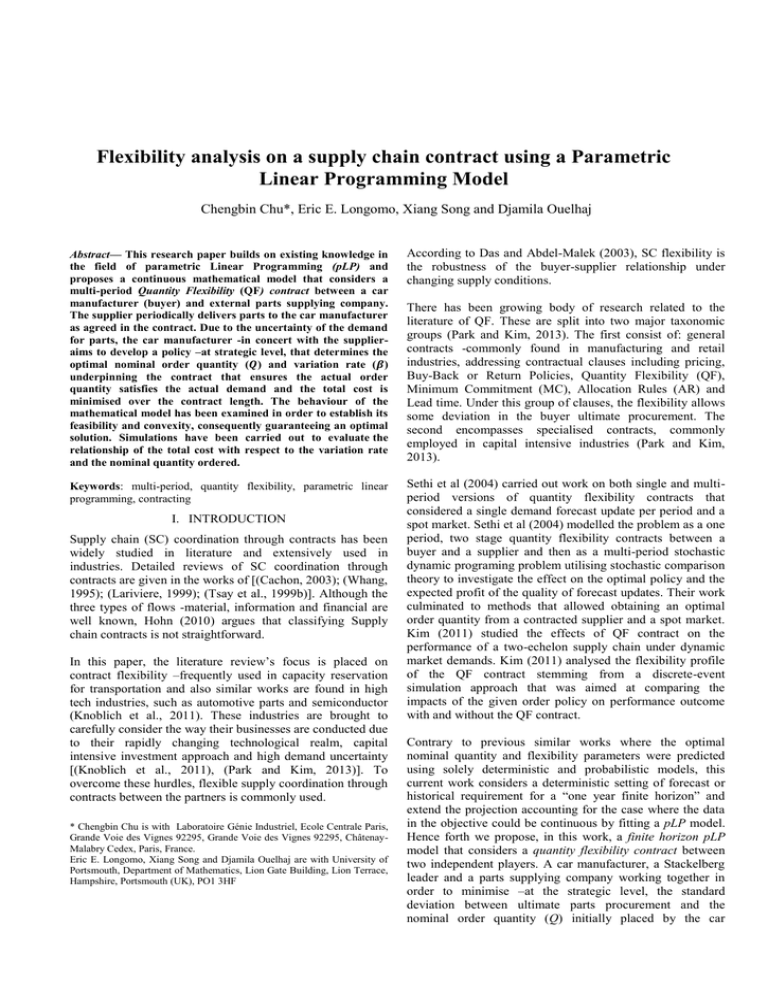
Flexibility analysis on a supply chain contract using a Parametric
Linear Programming Model
Chengbin Chu*, Eric E. Longomo, Xiang Song and Djamila Ouelhaj
Abstract— This research paper builds on existing knowledge in
the field of parametric Linear Programming (pLP) and
proposes a continuous mathematical model that considers a
multi-period Quantity Flexibility (QF) contract between a car
manufacturer (buyer) and external parts supplying company.
The supplier periodically delivers parts to the car manufacturer
as agreed in the contract. Due to the uncertainty of the demand
for parts, the car manufacturer -in concert with the supplieraims to develop a policy –at strategic level, that determines the
optimal nominal order quantity (𝑸) and variation rate (𝜷)
underpinning the contract that ensures the actual order
quantity satisfies the actual demand and the total cost is
minimised over the contract length. The behaviour of the
mathematical model has been examined in order to establish its
feasibility and convexity, consequently guaranteeing an optimal
solution. Simulations have been carried out to evaluate the
relationship of the total cost with respect to the variation rate
and the nominal quantity ordered.
According to Das and Abdel-Malek (2003), SC flexibility is
the robustness of the buyer-supplier relationship under
changing supply conditions.
Keywords: multi-period, quantity flexibility, parametric linear
programming, contracting
Sethi et al (2004) carried out work on both single and multiperiod versions of quantity flexibility contracts that
considered a single demand forecast update per period and a
spot market. Sethi et al (2004) modelled the problem as a one
period, two stage quantity flexibility contracts between a
buyer and a supplier and then as a multi-period stochastic
dynamic programing problem utilising stochastic comparison
theory to investigate the effect on the optimal policy and the
expected profit of the quality of forecast updates. Their work
culminated to methods that allowed obtaining an optimal
order quantity from a contracted supplier and a spot market.
Kim (2011) studied the effects of QF contract on the
performance of a two-echelon supply chain under dynamic
market demands. Kim (2011) analysed the flexibility profile
of the QF contract stemming from a discrete-event
simulation approach that was aimed at comparing the
impacts of the given order policy on performance outcome
with and without the QF contract.
I. INTRODUCTION
Supply chain (SC) coordination through contracts has been
widely studied in literature and extensively used in
industries. Detailed reviews of SC coordination through
contracts are given in the works of [(Cachon, 2003); (Whang,
1995); (Lariviere, 1999); (Tsay et al., 1999b)]. Although the
three types of flows -material, information and financial are
well known, Hohn (2010) argues that classifying Supply
chain contracts is not straightforward.
In this paper, the literature review’s focus is placed on
contract flexibility –frequently used in capacity reservation
for transportation and also similar works are found in high
tech industries, such as automotive parts and semiconductor
(Knoblich et al., 2011). These industries are brought to
carefully consider the way their businesses are conducted due
to their rapidly changing technological realm, capital
intensive investment approach and high demand uncertainty
[(Knoblich et al., 2011), (Park and Kim, 2013)]. To
overcome these hurdles, flexible supply coordination through
contracts between the partners is commonly used.
* Chengbin Chu is with Laboratoire Génie Industriel, Ecole Centrale Paris,
Grande Voie des Vignes 92295, Grande Voie des Vignes 92295, ChâtenayMalabry Cedex, Paris, France.
Eric E. Longomo, Xiang Song and Djamila Ouelhaj are with University of
Portsmouth, Department of Mathematics, Lion Gate Building, Lion Terrace,
Hampshire, Portsmouth (UK), PO1 3HF
There has been growing body of research related to the
literature of QF. These are split into two major taxonomic
groups (Park and Kim, 2013). The first consist of: general
contracts -commonly found in manufacturing and retail
industries, addressing contractual clauses including pricing,
Buy-Back or Return Policies, Quantity Flexibility (QF),
Minimum Commitment (MC), Allocation Rules (AR) and
Lead time. Under this group of clauses, the flexibility allows
some deviation in the buyer ultimate procurement. The
second encompasses specialised contracts, commonly
employed in capital intensive industries (Park and Kim,
2013).
Contrary to previous similar works where the optimal
nominal quantity and flexibility parameters were predicted
using solely deterministic and probabilistic models, this
current work considers a deterministic setting of forecast or
historical requirement for a “one year finite horizon” and
extend the projection accounting for the case where the data
in the objective could be continuous by fitting a pLP model.
Hence forth we propose, in this work, a finite horizon pLP
model that considers a quantity flexibility contract between
two independent players. A car manufacturer, a Stackelberg
leader and a parts supplying company working together in
order to minimise –at the strategic level, the standard
deviation between ultimate parts procurement and the
nominal order quantity (Q) initially placed by the car
manufacturer. This feat is accomplished by minimising the
order flexibility -which translates in practice to the
minimisation of the variation rate (𝜷). A natural constraint
of this exercise is that the optimal order quantity in each
period in the planning horizon is restricted within the
minimum and maximum order quantity level. The
collaboration between the two players will amount to
incentives on both parties in the form of reduced uncertainty
and optimum ordering cost for the supplier and the car
manufacturer respectively.
II. MODEL DEVELOPMENT
The model considered in the current work is an example of a
two-echelon SC, in which a QF contract is agreed between
two main players, a buyer and supplier. The buyer is
provided with some flexibility with respect to the nominal
ordering quantity 𝑄 but, is duty bound to commit to
minimum purchase quantity, 𝐿 (𝛽), below the initial order.
The supplier in return, agrees to meet the actual order
quantity (or firm order) provided that it falls below the
maximum allowable purchase quantity, 𝑈(𝛽) above the
nominal quantity. The supplier charges a unit purchasing cost
𝑝(𝛽) to contain risks. When signing the contract with the
supplier, 𝛽 and 𝑄 need to be decided to minimise the total
cost. This problem is a big challenge to the buyer due to the
high variation of the actual demand.
A. Notations
The following notations will be used throughout this paper.
i.
Input Data
𝑇
𝑑𝑡
ℎ
𝑠
ii.
Number of periods in the contracts, thus period,
t = 1,2, …, T, represents different periods within
the planning horizon
Demand at time t (unknown in reality. In this
paper, demand is forecasted using historical
data.)
Unit inventory holding cost per period
Unit shortage cost per period
Decision Variables
𝑥𝑡
𝛽
𝑄
𝑝(𝛽)
𝑈(𝛽)
𝐿(𝛽)
𝑣ℎ𝑠
𝐾𝑡
𝑔(𝛽, 𝑄, 𝑥)
Order quantity of period t, 𝑥 = (𝑥1 , … , 𝑥𝑇 )
Variation rate with respect to the nominal
quantity (𝑄)
Nominal order quantity
Unit purchasing cost in function of the
variation rate. Assumption is made in this
current work that 𝑝(𝛽) is a linear or piecewise
linear convex function
Upper bound on ordered quantity per period,
where 𝑈(𝛽) = 𝑄(1 + 𝛽) ≥ 𝑥𝑡
Lower bound on the ordered quantity per
period, where 𝐿(𝛽) = 𝑄(1 − 𝛽) ≤ 𝑥𝑡
Total holding /shortage cost
Purchasing cost at period t
Total cost over the length of the contract
B. Cost Analysis
In each period of the contract, three costs will be incurred Purchasing cost, inventory cost and holding cost. The total
cost is thus defined as the sum of these three costs. With
different order quantities in each period, the cost will be
different.
The purpose of the analysis is to determine the optimal
values of 𝜷 and 𝑸 that minimises the deviation between the
initial and ultimate procurement, consequently minimising
the total cost of purchase, inventory holding and shortage
costs.
Assumptions are made that:
All current or back ordered demands need to be
satisfied at the end of the contract meaning that no
ordering cost is incurred.
The unit purchase cost 𝑝(𝛽) is assumed to be linear
or piecewise linear convex function and is given by
the expression: 𝑝(𝛽) = 𝑐0 + 𝛽. 𝑐1
(1)
Where 𝑐0 , represents the minimal possible cost with
zero flexibility and 𝑐1 is a given fixed rate of
change of 𝑝(𝛽).
C. Construction of the cost function
If 𝑑1 , … , 𝑑 𝑇 are the demands for the next T periods and
backorder is allowed, two cases arise:
1.
Holding/shortage cost for period t (𝑣𝑡 )
ℎ ∙ ∑𝑡𝑖=1(𝑥𝑖 − 𝑑𝑖 ) If ∑𝑡𝑖=1(𝑥𝑖 − 𝑑𝑖 ) ≥ 0
𝑠 ∑𝑡𝑖=1(𝑑𝑖 − 𝑥𝑖 ) If ∑𝑡𝑖=1(𝑥𝑖 − 𝑑𝑖 ) ≤ 0
(1)
(2)
This leads to the following
𝑣𝑡 = max[ℎ ∑𝑡𝑖=1(𝑥𝑖 − 𝑑𝑖 ) , 𝑠 ∑𝑡𝑖=1(𝑑𝑖 − 𝑥𝑖 )]
2.
Purchasing Cost for period t (𝐾𝑡 )
𝐾𝑡 = 𝑝(𝛽) ∙ 𝑥𝑡
3.
(3)
(4)
The total cost can then be written as:
𝑓(𝛽, 𝑄, 𝒙) = ∑𝑇𝑡=1(𝑣𝑡 + 𝐾𝑡 )
(5)
D. Problem formulation
In this paper, we consider that backorder is allowed.
The optimisation problem can be formulated as:
Minimize: 𝑓(𝛽, 𝑄, 𝒙)
s.t:
𝑥𝑡 ≥ 𝑄(1 − 𝛽),
𝑡 = 1, 2, … , 𝑇
−𝑥𝑡 ≥ −𝑄(1 + 𝛽), 𝑡 = 1, 2, … , 𝑇
1≥𝛽≥0
𝑄 ≥0
Given the vector of order quantity,
𝒙∗ (𝛽, 𝑄) = 𝑎𝑟𝑔𝑚𝑖𝑛{𝑓(𝛽, 𝑄, 𝒙)|
𝑄(1 − 𝛽) ≤ 𝑥𝑡 ≤ 𝑄(1 + 𝛽), 𝑡 = 1, … , 𝑇},
and 𝑔(𝛽, 𝑄) = 𝑓(𝛽, 𝑄, 𝒙∗ (𝛽, 𝑄)).
(6)
(7)
(8)
Our problem is to find the values of 𝛽 and 𝑄 minimizing
𝑔(𝛽, 𝑄) such that 1 ≥ 𝛽 ≥ 0 and 𝑄 ≥ 0 .
The objective function (6) in Section II is nonlinear. To
linearize the objective function, we introduce the additional
decision variable and addition constraints as follows:
𝐽𝑡 :
The inventory holding/shortage cost of
period 𝑡, 𝑡 = 1, 2, … , 𝑇
𝐽𝑡 − ℎ ∑𝑡𝑖=1 𝑥𝑖 ≥ −ℎ ∙ 𝐷𝑡 , 𝑡 = 1, 2, … , 𝑇
(9)
𝑡
𝐽𝑡 + 𝑠 ∑𝑖=1 𝑥𝑖 ≥ 𝑠 ∙ 𝐷𝑡
𝑡 = 1, 2, … , 𝑇
(10)
𝑡
Where 𝐷𝑡 = ∑𝑖=1 𝑑𝑖 represents the cumulative demand
from initial to current period.
Assumption is made, without being restrictive, that
∑𝑇𝑡=1 𝑥𝑡 = ∑𝑇𝑡=1 𝑑𝑡 = 𝐷𝑇 , making ∑𝑇𝑡=1 𝐾𝑡 =
∑𝑇𝑡=1 𝑝(𝛽) ∙ 𝑥𝑡 = 𝑝(𝛽) ∙ 𝐷𝑇 independent of 𝑥𝑡 and
hence can be dropped from (6) when computing
𝑥 ∗ (𝛽, 𝑄) and from the optimisation process.
Define 𝑦𝑡 = 𝑥𝑡 − 𝑄(1 − 𝛽), 𝑡 = 1, 2, … , 𝑇 (11)
Applying the above substitutions and assumptions to the
initial mathematical model (6) – (8), we have the Primal pLP
expressed by:
𝑀𝑖𝑛𝑖𝑚𝑖𝑠𝑒 ∑𝑇𝑡=1 𝐽𝑡
s.t:
𝐽𝑡 − ℎ ∑𝑡𝑖=1 𝑦𝑖 ≥ ℎ[− 𝐷𝑡 + 𝑡𝑄(1 − 𝛽)]
𝑡 = 1, 2, … , 𝑇
𝐽𝑡 + 𝑠 ∑𝑡𝑖=1 𝑦𝑖 ≥ 𝑠[𝐷𝑡 − 𝑡𝑄(1 − 𝛽)] ,
𝑡 = 1, 2, … , 𝑇
−𝑦𝑡 ≥ −2𝑄𝛽
𝑡 = 1, 2, … , 𝑇
∑𝑇𝑡=1 𝑦𝑡 = 𝐷𝑇 − 𝑇𝑄(1 − 𝛽)
(12)
(13)
(14)
(15)
(16)
𝑦𝑡 ≥ 0
𝑡 = 1, 2, … , 𝑇
By introducing 𝜺 , ŋ, 𝜽 and 𝐪 as the multipliers of the
constraints (13) – (16) respectively, and letting:
∆𝑡 = 𝐷𝑡 − 𝑡𝑄(1 − 𝛽)
𝑡 = 1,2, … , 𝑇
(22)
Note that the first term, which is independent of x, has been
dropped from the LP, and must be reintroduced when
computing 𝑔.
III. LINEARIZATION OF THE MODEL
𝑔(𝛽, 𝑄) = 𝑝(𝛽)𝐷𝑇 + 𝑣(𝛽, 𝑄)
(17)
IV. THEORETICAL ANALYSIS
Notice that the primal pLP is a Right-hand-side pLP (RHSpLP) of parameters 𝛽 and 𝑄 and its dual is an “objective
function pLP” (OF-pLP). The examination of the behaviour
of the objective function is thus less complex using the dual
pLP. Since the examination of the joint convexity property of
𝑔(𝛽, 𝑄) with respect to both 𝛽 and 𝑄 is complicated. We
leave this proof for our research work.
In this paper, we are to examine the joint convexity property
of 𝑔(𝛽, 𝑄) by some simulation work. To validate our
simulation process, we provide the proof of the convexity of
𝑔(𝛽, 𝑄) by fixing either 𝛽 or 𝑄 first.
Theorem 1: Given a fixed value of Q, 𝑔(𝛽, 𝑄) is a convex
function with respect to parameter 𝛽.
Proof: Since from (22), we know that 𝑔(𝛽, 𝑄) = 𝑝(𝛽)𝐷𝑇 +
𝑣(𝛽, 𝑄) and 𝑝(𝛽)𝐷𝑇 are a convex function with respect to 𝛽
obviously, we just need to prove that 𝑣(𝛽, 𝑄) is a convex
function with respect to 𝛽. Since Q is fixed we use 𝑣(𝛽) to
replace 𝑣(𝛽, 𝑄) in the following discussion.
Let 𝜺 , ŋ and 𝜽 be T-vectors such that:
𝜺 = (𝜀1 , … , 𝜀𝑇 )𝑻 , ŋ = (ŋ1 , … , ŋ 𝑇 )𝑻 , 𝜽 = (𝜃1 … , 𝜃𝑇 )𝑻 and
𝒒 = (𝑞, … , 𝑞)𝑻 a unit vector, the solution vector of the dual
PLP can be written as 𝒔 = (𝒒, 𝜺, ŋ, 𝜽)
The objective function 𝑣(𝛽) can be written as (𝛽) = 𝑼(𝛽) ∙
𝒔 , where 𝑼(𝛽) = [(𝒄 + 𝜸𝛽)] is the coefficient vector.
We can assume without loss of generality that the dual pLP
problem can be expressed as:
𝑣(𝛽) = 𝑚𝑎 𝑥{𝑼(𝛽). 𝑺 | 𝑨. 𝑺 ≤ 𝒀, 𝑺 ≥ 0, 𝑨 ∈ 𝑅𝑚×𝑛 , 𝛽 ∈
[0,1]}
(26)
With A being the matrix of the coefficients of the constraints,
Y, being the set of vectors containing the right hand side of
the constraints, and S, the set of vectors containing the
decision vectors of the standard pLP problem.
The dual pLP of the primal pLP can be written as follows:
𝑀𝑎𝑥 ∆ 𝑇 𝑞 + ∑𝑇𝑡=1[−ℎ ∙ ∆𝑡 𝜀𝑡 + 𝑠 ∙ ∆𝑡 ŋ𝑡 − 2𝑄𝛽. 𝜃𝑡 ]
𝑡 = 1,2, … , 𝑇
S.t:
(18)
−ℎ ∑ 𝜀𝑖 + 𝑠 ∑ ŋ𝑖 − 𝜃𝑡 + 𝑞 ≤ 0
(19)
𝑇
𝑖=𝑡
𝑇
𝑖=𝑡
𝑡 = 1, 2, … , 𝑇
𝜀𝑡 + ŋ𝑡 = 1
𝑡 = 1, 2, … , 𝑇
𝜀𝑡 , ŋ𝑡 , 𝜃𝑡 ≥ 0
The feasibility of 𝑣(𝛽) is clearly independent of the objective
function, hence forth, only the case when the problem is
feasible is addressed.
Let 0 ≤ β ≤ 1, be the range of values of β for which a
finite maximum exists for 𝑣(𝛽)
(20)
(21)
Let 𝑣(𝛽, 𝑄) be the optimal value of the objective function of
this (primal or dual) LP, then:
Let 𝛽1 and 𝛽2, be any two points in the interval [0, 1]
such that 𝒔∗𝟏 𝑎𝑛𝑑 𝒔∗𝟐 are the corresponding optimal
solutions to the dual LP with objective functions 𝑣(𝛽1 )
and 𝑣(𝛽2 ).
∀ 𝜶 ∈ [𝟎, 𝟏], we define 𝛽3 = 𝛼. 𝛽1 + (1 − 𝛼). 𝛽2 and
let the optimal solution for 𝑣(𝛽3 ) be 𝒔∗𝟑 and 𝑣 ∗ (𝛽3 ) be
TABLE II.
its optimal objective value
𝑈(𝛽3 ). 𝒔∗𝟑
𝑣 ∗ (𝛽3 ) =
= (𝒄 + 𝜸𝛽3 ). 𝒔∗𝟑
= [𝒄 + (𝛼. 𝛽1 + (1 − 𝛼). 𝛽2 ). 𝜸]. 𝒔∗𝟑
= α. (𝒄 + 𝛽1 . 𝜸). 𝒔∗𝟑 + (1 − 𝛼). (𝒄 + 𝛽2 . 𝜸). 𝒔∗𝟑
≤ 𝛼. 𝑣 ∗ (𝛽1 ) + (1 − 𝛼). 𝑣 ∗ (𝛽2 )
(27)
The above inequality holds since:
𝒔∗𝟑 is feasible solution to the Dual pLP with objective
functions 𝑣(𝛽1 ) and 𝑣(𝛽2 ).
Thus given a fixed value of 𝑄 , 𝑣(𝛽, 𝑄) is a convex
function with respect to parameter 𝛽 . And in general, the
theorem 1 holds.
Corollary 1: Given a fixed value of 𝛽, 𝑔(𝛽, 𝑄) is a convex
function with respect to parameter 𝑄.
V. COMPUTATIONAL RESULTS
We are to explore the convexity of 𝑔(𝛽, 𝑄) with respect to
and 𝑄 using simulation. For each combination of 𝛽
and 𝑄, the dual PLP model was solved with the Solver
embedded in Microsoft Excel 2007, which gives
us 𝑣 ∗ (𝛽, 𝑄). The feasible range of 𝛽 and 𝑄 derived from
equation (7) and (8) are given in Table 1.
𝒕 (month)
𝒅𝒕 (units)
𝑫𝒕 (units)
1
100
100
2
100
200
3
100
300
4
90
390
5
110
500
6
120
620
7
80
700
8
70
770
9
130
900
10
80
980
11
120
1100
12
100
1200
Where 𝑫𝒕 is the accumulated demand.
The holding and shortage costs are stationary through the
planning horizon, i.e., ℎ𝑡 = ℎ, 𝑠𝑡 = 𝑠. The minimum possible
cost, 𝑐0 and 𝑐1 are fixed. According to the assumption
∑𝑇𝑡=1 𝑥𝑡 = ∑𝑇𝑡=1 𝑑𝑡 = 𝐷𝑇 ,
we
have
the
total
demand, 𝐷𝑇 =1200.
𝛽
TABLE I.
FEASIBLE RANGE OF 𝛽 AND 𝑄
Variation rate (𝛽)
Nominal quantity (𝑄)
[0, 1]
𝐷𝑇
[
,
𝑇(1 + 𝛽)
𝐷𝑇
]
𝑇(1 − 𝛽)
To make the flexibility analysis of the contract, it is
necessary to provide the feasible range of 𝛽 and 𝑄 in
another way round, where the range of 𝛽 is the function of
𝑄. That is, for a fixed value 𝑄, all possible 𝛽 values needs to
be explore to find the best one to provide the lowest total
cost. From Table 1, it is easily deduced that the range of 𝛽 is
𝐷
𝐷
[max(1 − 𝑇 , 𝑇 − 1), 1].
𝑄∙𝑇
𝑄∙𝑇
A. Input Data
The input data to the dual PLP model is given in Table 2 and
Table 3, where 𝑇 = 12 months in a year. Each period is one
month.
Table 2 below, represents a one year historical demand
(forecast) and the accumulation of the demands for each
period. Table 3 shows that the demand is not stationary over
the planning horizon.
DEMAND IN A YEAR
TABLE III.
INPUT DATA
𝒉 (£)
𝒔(£)
𝒄𝟎 (£)
𝑫𝑻 (units)
𝒄𝟏 (£)
2
10
10
1200
0.5
B. Optimisation of the pLP model
Since computing all the combinations of 𝛽 and 𝑄 is
exhaustive, and bearing in mind that the convexity of the
dual pLP with respect to 𝛽 when 𝑄 is fixed and the
convexity of the dual pLP with respect to 𝑄 when 𝛽 is fixed
were theoretically verified (Theorem 1). Decision was made
to conduct the optimisation using Equal Interval Search
(EIS) Method- which helped narrow the sampling space.
EIS Method is one of the techniques used for finding the
extreme value (minimum or maximum of a strictly unimodal
function by successively narrowing the range of values inside
which the extreme value is known to exist.
The basic idea of this EIS Method to explore all possible
solutions of 𝑔(𝛽, 𝑄) is to explore all the possible value of 𝑄
by starting with𝑄 = 0, then increase the value of 𝑄 by 1
each time. With a give value 𝑄 , we don’t need to explore all
the values of 𝛽 in [max(1 −
𝐷𝑇
𝐷
, 𝑇
𝑄∙𝑇 𝑄∙𝑇
− 1), 1].
Due to the fact that the convexity of the dual pLP with fixed
value 𝛽 was theoretically verified, we can apply EIS Method
to explore limited number of value 𝑄 without loss of
optimality.
SIMULATION RESULTS FOR DIFFERENT 𝑄 VALUES.
TABLE V.
𝑸
𝛽
𝑔(𝛽, 𝑄)
𝑸
𝛽
𝑔(𝛽, 𝑄)
To help simulate the behaviour of 𝑔(𝛽, 𝑄) , a macro –set of
VBA codes was written and imbedded in Excel to implement
EIS Method.
91
0.26
12,208
102
0.22
12,150
92
0.25
12,200
103
0.22
12,154
93
0.24
12,192
104
0.23
12,159
C. Optimisation results
94
0.22
12,184
105
0.24
12,163
Table 4 gives part of the simulation results, where 𝑄 is fixed
to 100, which is the mean of the forecasted demand 𝒅𝒕 and
the value of 𝛽 is explored using EIS method.
95
0.21
12,176
106
0.25
12,167
96
0.21
12,169
107
0.25
12,172
97
0.19
12,161
108
0.26
12,176
98
0.21
12,154
109
0.27
12,180
99
0.20
12,147
110
0.27
12,184
100
0.20
12,140
SIMULATION RESULTS FOR 𝑄 = 100
TABLE IV.
𝑸
𝜷
𝑽𝒉𝒔
𝑲𝒕
𝒈(𝜷, 𝑸)
100
0.00
320
12,000
12,320
100
0.50
0
12,300
12,300
100
0.51
0
12,306
12,306
100
1.00
0
12,600
12,600
100
0.01
300
12,006
12,306
12220
100
0.25
10
12,150
12,160
12200
100
0.26
8
12,156
12,164
100
0.49
0
12,294
12,294
The graph of the simulation work in Table 5 is shown in
Figure 1.
𝑔(𝛽, 𝑄)
12240
Total Cost vs. Value Q
12180
12160
c1=0.5
12140
100
0.02
280
12,012
12,292
100
0.13
98
12,078
12,176
100
0.14
84
12,084
12,168
Figure 1. Relationship of total cost 𝑔(𝛽, 𝑄) and variable 𝑄
100
0.24
12
12,144
12,156
100
0.15
70
12,090
12,160
100
0.19
30
12,114
12,144
100
0.20
20
12,120
12,140
100
0.23
14
12,138
12,152
It can be seen that 𝑔(𝛽, 𝑄) is a unimodal function with
respect to both 𝛽. In the future, we aim to explore this feature
theoretically.
Table 6 below gives the best simulation result for the Data
Input provided in section A. The optimum variation rate (𝛽),
the optimum nominal quantity (𝑄), the total holding/shortage
cost 𝒗 (𝛽, 𝑄) and total cost 𝑔(𝛽, 𝑄) over the length of the
contract are all listed.
100
0.21
18
12,126
12,144
100
0.22
16
12132
12148
12120
90
100
Q
TABLE VI.
It is noted in Table 4 that the optimal total cost, 𝑔(𝛽, 100) =
12,140, is achieved when 𝛽 = 0.20.
Table 5 provides the simulation results for different 𝑄 values.
For each fixed value 𝑄𝐹 , only the 𝛽 value, which can provide
minimum 𝑔(𝛽, 𝑄𝐹 ), is kept in one row of Table 5. Due to the
size of the paper, we just provide the results of 𝑄 in the
interval [90, 110].
110
120
OPTIMUM RESULT FROM SIMULATION WORK
∗
𝒄𝟏 = 𝟎. 𝟓
𝜷
𝑸∗
𝒗∗ (𝜷, 𝑸)
𝒈∗ (𝜷, 𝑸)
Optimum
0.2
100
20
12140
VI. CONCLUSION
A successful simulation of pLP problem was achieved in this
work. The results shown in fig.1 clearly validate the
conclusion that 𝑔(𝛽, 𝑄) is convex with respect to 𝛽 and 𝑄
the theoretical proof of joint convexity of both
𝛽 and 𝑄 will be our future research. Also, the trade-off of
ℎ, 𝑠, 𝑐0 and 𝑐1 with respect to the total cost will also be
analysed in the future.
ACKNOWLEDGMENT
The authors would like to thank the reviewers for their
valuable and detailed comments which have greatly
improved the presentation of this work.
REFERENCES
[1]
[2]
[3]
[4]
[5]
[6]
[7]
[8]
[9]
[10]
[11]
[12]
[13]
[14]
Beamon, B.M, 1998. “Supply chain design and analysis: Models and
methods”. International Journal of Production Economics, 55, 281294.
Das, S.K., Abdel-Malek, L., 2003. “Modelling the flexibility of order
quantities and lead times in supply chain”. International journal of
production Economics 85 (2), pp171-181
Gerard P. Cachon, 2003. “Supply Chain Coordination with Contracts”
Hohn, M.I., 2010. “Relational supply contracts, Lecture Notes in
Economics and Mathematics Systems”, Springer-Verlag Berlin
Heidelberg,
Jing Checn, 2012. “Contracting in a newsvendor problem”. Journal of
Modelling in Management”, Vol. 7 No. 3, pp.242-256
Keely L. Croxton, Sebastian J. Garcia-Dastugue, Douglas M. Lambert
and Dale S. Rogers, 2001. “The supply Chain Management Process”
The international Journal of Logistics Management, pp-01
Keen, S.E., Kanchanapiboon, A., Das, S.K., 2010. “Evaluating supply
chain flexibility with order quantity constraints and lost sales”,
International journal of Production Economics 126, pp 181-188.
Kim, W.S., 2011. “Order quantity flexibility as a form of customer
service in a supply chain contract model”, Flexible Services and
Manufacturing Journal 29(3), pp 290-315.
Knoblich, K., Ehm, H., Heavey, C., Williams, P., 2011. “Modelling
Supply Contracts in Semiconductor Supply Chains”, IEEE
Lariviere, M.A., 1999. “Supply chain contracting and coordination
with stochastic demand”. In: Tayur, S., Magasine, M., Ganeshan, R.
(Eds.), Quantitative Models for supply chain management. Springer.
Liu Bein-li and MA Wen-hui, 2008. “Application of Quantity
flexibility contract in perishable products supply chain coordination”,
IEEE
Nihar Sahay and Marianthi G. Ierapetritou, 2013. “Centralized Vs.
Decentralized Supply Chain Management Optimization”
Sethi, S.P., Yan, H., Zhang, H., 2004. “Quantity flexibility contracts:
optimal decision with information updates, Decis”. Sci. 35 691-712.
Tsay, A.A, 1999. “Quantity flexibility contract and supplier-customer
incentives”, Management science 45 (10), pp1339-1358.
